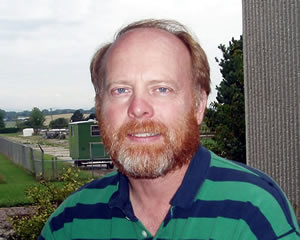Upper Midwest Environmental Sciences Center
|
|
| Home/ Overview/ Science Programs/ Data Library/ Products and Publications/States/ Rivers/Teachers and Students/ Links/ Contact/ Search |
 Kevin P. Kenow
Kevin P. KenowPosition title: Research Wildlife Biologist
Email: kkenow@usgs.gov
Phone: 608.781.6278
Fax: 608.783.6066
Education:
1989 M.S., Wildlife Ecology, University of Wisconsin
1979 B.S., Wildlife Biology, University of Minnesota
Primary Responsibilities/Activities:
Research focuses on issues related to conserving migratory birds and their habitats along the Upper Mississippi River (UMR) and development of regional and national common loon conservation strategies. Current activities include evaluating the vegetation response to seasonal pool-wide water level reductions on the UMR, assessing the level and impacts of boating disturbance to waterfowl on important staging areas during fall migration, determining the distribution of tundra swans on the UMR and assessing the availability and impacts of tundra swans on food resources, characterizing factors that may have consequences on embryo and chick development in common loons, determining the level of mercury exposure that results in detrimental effects on fitness and survival of loon embryos and resulting chicks, and identifying common loon migration movements and relations between breeding and wintering grounds.
Research Interests:
Active Projects:
Select Publications:
Kenow, K. P., J. E. Lyon, R. K. Hines, and A. Elfessi. 2007. Estimating biomass of submersed vegetation using a simple rake sampling technique. Hydrobiologia 575:447-454.
Kenow K.P, Meyer M.W., Hines R.K., Karasov W.H. 2007. Distribution and accumulation of mercury in tissues and organs of captive-reared common loon (Gavia immer) chicks. Environmental Toxicology and Chemistry 26:1047-1055.
Kenow K.P, Grasman K.A, Hines R.K., Meyer M.W., Gendron-Fitzpatrick A., Spalding M.G., Gray B.R. 2007. Effects of methylmercury exposure on the immune function of juvenile common loons. Environmental Toxicology and Chemistry 26(7):1460-1469.
Kenow, K. P., J. M. Nissen, R. Drieslein, and E. M. Thorson. 2004. Tundra swan research needs on the Upper Mississippi River. Pages 180-189 in D. K. Weaver, M. H. Linck, and R. E. Shea, editors. Selected Papers of the Nineteenth Trumpeter Swan Society Conference. North American Swans 32(1).
Kenow, K. P., C. E. Korschgen, J. M. Nissen, A. Elfessi, and R. Steinbach. 2003. A voluntary program to curtail boat disturbance to waterfowl during migration. Waterbirds 26:77-87.
Kenow, K. P., M. W. Meyer, D. C. Evers, D. C. Douglas, and J. Hines. 2002. Use of satellite telemetry to identify Common Loon migration routes, staging areas and wintering Range. Waterbirds 25:449-458.
Links:
Climate Chamge Symposium 2007
GIS Data for Pool 5 Drawdown Project Background
Geographic Information System Tools for Conservation Planning
Factors affecting common loon (Gavia immer) productivity
Managing pathways of biological production of large rivers (vegetation response to a water-level drawdown of Pool 8 of the Upper Mississippi River)
Program SUBSAMPL/HABUSE: Integrating SAS and GIS software to improve habitat use estimates from radiotelemetry data